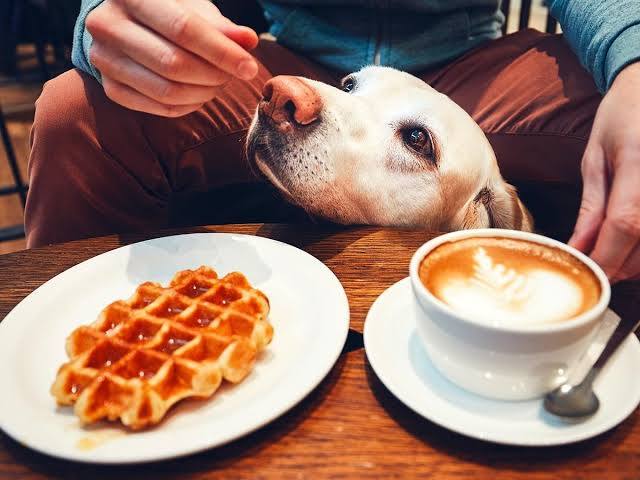Last Sunday, I was enjoying a cozy brunch with bacon, eggs, and a stack of warm pancakes when my dog sat beside me with those curious eyes that make saying no impossible. I wondered if it’s OK for dogs to eat a small piece of my breakfast treat. From my experience as a pet lover, a bite or two of plain pancakes isn’t really off-limits, but it’s important to remember that most human food—especially those with salt, fat, or syrup—is not ideal for your pup. While sharing a simple, unseasoned bit of pancake might seem harmless, avoid adding bacon or extra eggs cooked in grease, as these can upset your dog’s stomach. Keep it simple, light, and occasional—because not every brunch favorite is made for furry friends.

Can Dogs Have Pancakes?
As a dog owner, I know how happy our furry friends get when we share a treat from our plate, but it’s important to make sure it’s safe. Giving your dogs a small amount of plain pancake once in a while is generally fine, as long as it’s free from toxic spices like nutmeg or harmful ingredients such as chocolate chips and sugary toppings. I’ve learned through experience that even though pancakes smell delicious, keeping them plain and simple helps avoid any tummy troubles. Always remember, moderation is key—your dog doesn’t need much to feel loved.
Are Pancakes Bad for Dogs?
From my years of caring for my pet, I’ve learned that while pancakes are generally non-toxic for your dog, they don’t offer much nutrition either. These fluffy bites are mostly empty calories, which means they should only be given as a special treat and not a regular meal. I occasionally let my dog enjoy a small piece infrequently and in limited amounts, just to make him feel included during breakfast time—but always with the understanding that moderation keeps him happy and healthy.
Can Dogs Eat Pancakes With Syrup?
Whenever I pour that golden liquid syrup over my pancakes, my pet watches eagerly, hoping for a taste. But as tempting as it looks, dogs should never have artificial syrups or anything containing xylitol, as it’s highly toxic to them. Even regular sugar or added sugar from sweet toppings like Nutella, chocolate, or flavored spices such as nutmeg can cause serious health problems. I’ve seen dogs develop obesity and even pancreatitis from eating too many sugary foods or those with saturated fats like butter, which is why I always think twice before sharing.
If you really want to give your pet a treat, stick to plain pancakes with a drizzle of natural maple syrup made from the tree itself, and only in moderate amounts. Avoid heavy toppings, and instead, go for fresh fruit or light compotes with natural sugars, which are less problematic and somewhat more healthy. Still, even these should be offered sparingly to protect your dog’s health and prevent obesity over time.
How To Prepare Pancakes for Dogs
When I make plain pancakes for my dog, I like to get a little creative while keeping them healthy. A small pancake can be turned into a tasty topper by adding a dollop of canned dog food or mixing in some dog-friendly fruits and veggies like apples, bananas, or blueberries. Sometimes, I enjoy wrapping a dog biscuit inside a pancake for a fun, crunchy surprise that my pet absolutely loves. This simple twist keeps their treat interesting while ensuring it stays safe and wholesome.
How Many Pancakes Can Dogs Eat?
When feeding pancakes to your dog, it’s important to remember that a human-sized pancake is far too much for them. Pancakes should only be a snack and served in very small portions depending on your dog’s size. From my own experience, following recommended portion sizes helps prevent tummy troubles and keeps your pet healthy. For extra-small dogs under 10 pounds, such as Yorkies, Chihuahuas, and Pomeranians, only a tiny piece of plain pancake once a week is safe. Even Pugs, who love food, should stick to a very small portion to avoid unnecessary calories.
For small dogs weighing 10–25 pounds, like Basenjis, Beagles, or Miniature American Shepherds, a quarter of a plain pancake once a week is plenty. I’ve noticed these breeds can handle slightly more, but moderation is still key to prevent weight gain. Medium dogs around 25–50 pounds, such as Basset Hounds, Border Collies, and Australian Cattle Dogs, can have about half a plain pancake each week without issues—provided it’s not cooked with butter or syrup.
When it comes to large dogs weighing 50–90 pounds, including Pit Bulls, German Shepherds, Labrador Retrievers, and Australian Shepherds, a single small pancake once a week is enough. For extra-large dogs over 90 pounds, like Newfoundlands, Bernese Mountain Dogs, Saint Bernards, and Great Pyrenees, one large pancake per week is the maximum recommended portion. No matter the breed, I always make sure the treat is a plain pancake with no toppings or additives, ensuring my dogs enjoy their snack safely and happily.
Other Foods You Can Feed Your Dog
When I started cooking for my pet, I discovered many fun and dog-friendly recipes that go beyond pancakes. Simple no-bake treats like Biscotti made with peanut butter and a hint of jelly, or raspberry cookies, are great options if kept natural and unsweetened. I even tried making Disney dog donuts and carob-mint cookies, which turned out to be a hit with my dog. Just remember, all these treats should fit within your dog’s daily caloric intake and be balanced with high-quality dog food to keep them healthy and happy.
Can dogs eat flour in pancakes?
From my own baking experience, a little flour in pancakes is not toxic to dogs, so if your dog ends up consuming a small amount, it’s usually harmless. However, problems can arise if the dough contains yeast, as that can cause serious issues during digestion. Some dogs may also show increased thirst and need more water to help their system handle the process, so it’s best to keep an eye on them and only offer tiny portions made with plain, safe ingredients.
How many pancakes can I give my dog?
When it comes to sharing pancakes with your furry friend, portion size really matters. For a small dog, just a few bites of pancake are enough, while a large breed might be able to eat almost a whole pancake without trouble. From my experience, it’s best to ease feeding and offer pancakes occasionally, since too much can lead to an upset stomach, bloating, or unnecessary calories beyond their daily recommended intake. Keeping portions light helps your pup enjoy the treat without affecting their health.
Can dogs eat pancake with maple syrup?
Many dogs love to eat sweet treats like pancakes, but adding syrup can be risky. From my own experience, the high sugar content in maple syrup can be bad for your dog and may cause stomach upsets if eaten often. While a tiny drizzle might not harm them, it’s best to keep pancakes plain and avoid sugary toppings to keep your furry friend’s tummy happy and healthy.
Is pancakes ok for dogs?
From my own kitchen experience, I’ve learned that dogs can enjoy a small amount of plain pancake as an occasional snack, and it’s usually safe if made without harmful ingredients. When my dog looks happy waiting for a bite, I make sure the pancakes have no toxic spices like nutmeg, or sweet extras such as chocolate chips or sugary toppings. It’s fun to share with your furry friend, but keeping the treat simple and light helps avoid any tummy troubles and keeps your pup’s tail wagging.
Can a dog lick flour?
I once caught my pup sneaking a lick of flour while I was making pancakes, and it made me wonder if it could cause any issues. A tiny amount usually isn’t harmful, but if your dog has ingested a lot, you might notice increased thirst or gastrointestinal troubles such as vomiting, diarrhea, or even loss of appetite. These signs can mean your dog’s stomach is upset, so it’s always best to keep an eye on them and contact your veterinarian if anything seems off.
